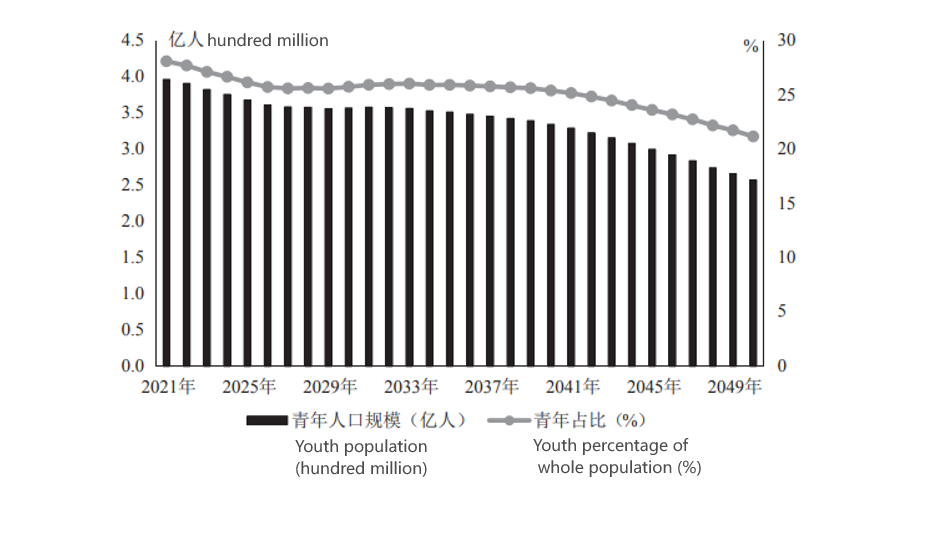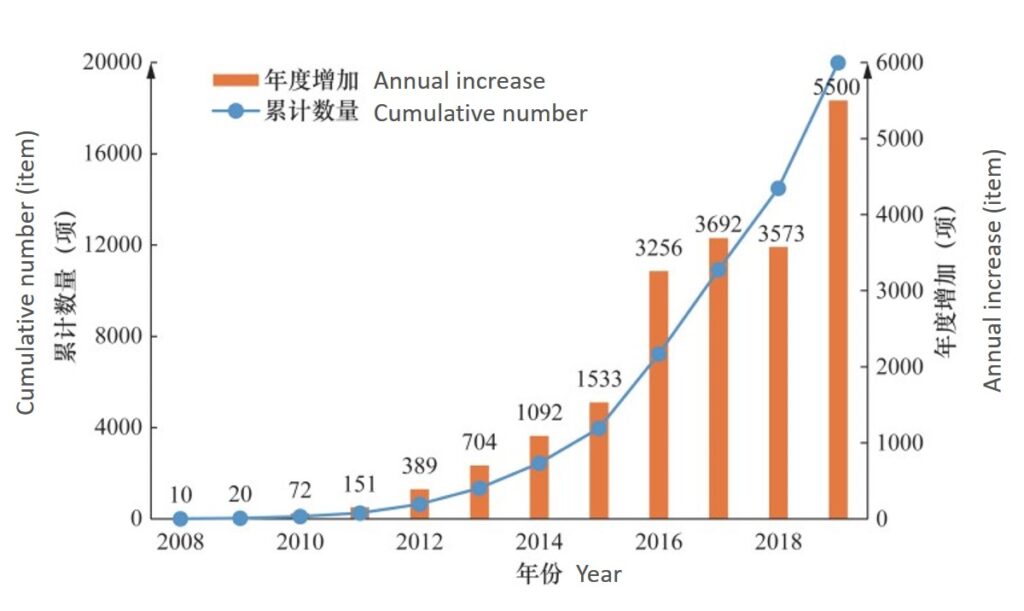中国房地产业的重要性
Importance of China’s Real Estate Industry
中国房地产业规模庞大,链条深远,涉及领域广泛,其增加值在GDP中的占比约为7%,与建筑业共同构成了国民经济的支柱,合计贡献高达14%。此外,房地产业在金融领域的影响力也不容忽视,房地产贷款及以房地产为抵押品的贷款占全部贷款余额的39%,显示出其在金融稳定中的关键作用,是一个具有系统重要性的行业,其影响深远且广泛。
China’s real estate industry is large in scale, long in industrial and supply chains and covers a wide range of fields. Its added value accounts for over 7% of GDP, plus the construction industry accounting for 14%, which is the pillar industry of the national economy. In addition, the influence of the real estate industry in the financial sector should not be overlooked. The real estate loans and loans secured by real estate account for 39% of the total loan balance, showing its key role in financial stability. Thus, the real estate industry is an industry of systemic importance with far-reaching and wide-ranging influences.
中国房地产业面临的问题
Problems Facing China’s Real Estate Industry
然而,中国房地产行业也面临着一系列前所未有的挑战。国家统计局数据显示,2023年末全国常住人口城镇化率为66.16%,部分城镇已超70%,尽管和发达国家80%的平均水平相比仍有增长潜力,但住宅的供应量已超过有效需求量。
同时,作为购房主力军的青少年数量也呈下降趋势,中国青少年研究中心青年研究所助理研究员周宇香预测,到2050年中国14-35岁青年人口将从目前的接近4亿降至2.57亿。中国人口与发展研究中心和联合国人口基金驻华代表处预测,中国的总人口到2050年预计从目前的14.4亿将至约12.9亿。这意味着未来的购房需求量和需求结构将发生变化,房地产企业需更加注重满足不同年龄段、不同家庭结构的需求。
此外,2000年前建成的大量老旧小区也面临住房面积小、质量差、配套不齐全的问题,居民对居住环境的舒适度和便利性要求越来越高,住房改善性需求旺盛。宏观层面上,房地产行业进入去杠杆和资产重组阶段,房地产企业难以通过自身力量消化沉淀的资产,导致行业持续低迷。
总的来说,未来房地产发展不能再仅依赖于数量的扩张,而需要在发展模式上进行深层次的结构性变革,更加强调质量的提升,并采取行动改善已有建筑。
However, the real estate industry in China is also facing a series of never experienced formidable challenges. According to data from the China National Bureau of Statistics, the national urbanization rate of the resident population reached 66.16% at the end of 2023, with some cities exceeding 70%. Although there is still growth potential compared to the average level of 80% in developed countries, the supply of residential units has overcome the effective market needs.
At the same time, the number of young people, who are the main force in home buying, is declining. Zhou Yuxiang, assistant researcher at the Youth Research Institute of the China Youth Research Center, predicts that the population of young people aged 14-35 in China will decrease from almost 400 to 257 million by 2050. Moreover, it is forecasted by UNFPA Country Office in China and China Population and Development Research Center that the overall population will decrease from the actual 1.44 billion to about 1.29 billion in 2050. This means that the future housing demand and demand structure will undergo changes, and real estate companies need to pay more attention to meeting the needs of different age groups and family structures.
Additionally, a significant number of pre-2000 housing units are small, of poor quality, and lack adequate facilities. Residents are increasingly demanding comfort and convenience in their living environments, leading to a strong demand for housing improvement. On a macro level, the real estate sector is already entered a phase of deleveraging and asset restructuring, making it difficult for real estate enterprises to independently absorb the accumulated assets, resulting in a prolonged downturn in the industry.
All in all, the future real estate development cannot rely anymore on quantity expansion but requires deep structural change in its development mode with a greater emphasis on quality improvement as well as action towards already existing buildings.

来源:周宇香 – 2021—2050年中国青年人口规模(亿人)及占总人口比例预测(%)
Source: Zhou Yuxiang – Population size of Chinese 14-35 year-old youth (in hundred million) and its predicted percentage of total population from 2021 to 2050
中国政府的政策支持
Policy Support from the Chinese Government
为了应对房地产行业的困境,中国政府采取了一系列措施,来解决房地产和实体经济失衡问题。2024年2月20日,央行授权全国银行间同业拆借中心公布,贷款市场报价利率(LPR):1年期LPR为3.45%,5年期以上LPR为3.95%,迎来有史以来的最大降幅以提振居民住房消费的意愿和能力。
In response to the challenges facing the real estate industry, the Chinese government has implemented a series of measures whichare addressing the imbalance between the real estate sector and the real economy. On February 20, 2024, the People’s Bank of China authorized the National Interbank Funding Center to announce the Loan Prime Rate (LPR), with a historic drop: the 1-year LPR is set at 3.45%, and the LPR for terms over 5 years is 3.95%. This move aims to stimulate the willingness and ability of house buyers.
中国房地产业的发展方向
Development Direction of China’s Real Estate Industry
2023年,全国住房城乡建设工作会议指出,住房和城乡建设工作要“以努力让人民群众住上更好的房子为目标”,从“好房子”到“好小区”,从“好小区”到“好社区“”,从“好社区”到“好城区”,进而把城市规划好、建设好、治理好,推动建筑业工业化、数字化、绿色化转型升级。
In 2023, the National Housing and Urban-Rural Construction Work Conference emphasized the direction for the development of the real estate industry. The focus was set on the goal of ensuring that “the people have access to better housing”, progressing from “good houses” to well-planned neighborhoods, and further advancing from these communities to well-designed urban areas. The overarching aim is to optimize urban planning, construction, and governance, thereby driving the transformation and upgrading of the construction industry towards industrialization, digitization, and “greenization”.
如何打造好房子——房地产发展新模式
How to Build “Good Houses” – A New Model for Real Estate Development
住房城乡建设部部长倪虹指出,当前房地产处于高质量发展阶段,好房子有新要求,亟需构建新的发展模式:
- 坚持“绿色、低碳、智能、安全”的原则。从建筑层高、电梯、隔音、绿色、智能、无障碍等方面入手,提高住宅建设标准。强化科技驱动,研究面向未来的好房子建造技术,组织筹建新一批重点实验室和工程技术创新中心等科技创新平台,加快推动“数字住建”落地实施。
- 在体制机制上,一是建立“人、房地、钱”要素联动的新机制,二是建立房屋从开发建设到维护使用的全生命周期管理机制。
- 实施好规划建设保障性住房、城中村改造和“平急两用”公共基础设施建设“三大工程”,同时一视同仁满足不同所有制房地产企业合理融资需求,促进金融与房地产良性循环。
Ning Hong, Minister of the Ministry of Housing and Urban-Rural Development (MoHURD), pointed out that the current stage of real estate should be characterized by high-quality development, demanding new standards for “good houses”. It is imperative to establish a new development model with the following key principles:
- Adhering to the principles of “green, low-carbon, intelligent, and safe“. Enhance engineering standards, particularly for good houses, issuing specifications covering height, elevators, sound insulation, green features, intelligence, and accessibility. Drive technological advancements, research future-oriented building technologies, and expedite the promotion of “digital housing and construction,” including establishing key laboratories and innovation centers.
- In terms of institutional mechanisms, first, establish a new mechanism that links the elements of “people, real estate, and funds.” Second, establish a comprehensive life-cycle management mechanism for housing, covering development, construction, maintenance, and use.
- Implement the “three major projects” – effective planning and construction for guaranteed affordable housing, urban village transformation, and the construction of “dual-use” public infrastructure. Simultaneously, treat all types of real estate enterprises impartially, meeting their reasonable financing needs to promote a symbiotic relationship between finance and real estate.

来源:住建部 – 中国2008-2019年获得住建部绿色建筑评价标识的项目数量
Source: MoHURD – The number of projects in China that received green building certification from 2008 to 2019
从“好房子”到“好城市”的市场机遇——工业化、数字化、绿色化转型
Market Opportunities from “Good Houses” to Cities: Industrial, Digital and Green Transformation
中国房地产工业化、数字化、绿色化转型是房地产行业在多个层面上的深刻变革,旨在提高行业效率、推动可持续发展,并满足现代社会对高品质居住环境的需求。
The industrial, digital and green transformation of China’s real estate is a profound change in the real estate industry on multiple levels, aiming to improve the industry’s efficiency, promote sustainable development, and meet the modern society’s demand for high-quality living environments.
1. 工业化转型
1. Industrial Transformation
- 效率提升与成本控制:工业化转型带来了标准化、预制化和高效化的生产方式,使得房地产项目的建设周期大大缩短,质量得到显著提升。这不仅提高了房地产企业的运营效率,也为整个行业带来了成本节约和效益提升的机会。
- 品质保障与需求满足:工业化生产方式有助于保证建筑质量,满足消费者对高品质住宅的需求。同时,通过灵活调整设计方案,可以更好地满足市场多样化的需求。
- 催生新材料、新技术:工业化转型也催生了对于新型低碳建筑材料、构件和技术的需求,为相关产业链的发展提供了广阔的市场空间。
- Enhanced Efficiency and Cost Control: The transition to industrialization brings about standardized, prefabricated, and efficient production methods, significantly shortening the construction cycles of real estate projects and markedly improving quality. This not only boosts operational efficiency for real estate enterprises but also presents opportunities for cost savings and increased benefits for the entire industry.
- Quality Assurance and Demand Satisfaction: Industrialized production methods help ensure building quality; meeting consumers’ demands for high-quality residences. Simultaneously, by flexibly adjusting design schemes, it becomes possible to better meet the diverse needs of the market.
- Catalyst for New Materials and Technologies: The shift towards industrialization also stimulates demand for innovative, low-carbon building materials, components, and technologies, providing a broad market space for the development of related industry chains.
2. 数字化转型
2. Digital Transformation
- 智能化管理与服务升级:数字化转型使得房地产企业能够利用大数据、人工智能等技术,实现智能化管理和服务升级。这不仅能够提升客户满意度,还能为企业创造新的增值服务收入。
- 提高房地产企业的运营效率和管理水平,降低运营成本
- 带来金融科技的融合创新机会,为行业的可持续发展注入了新的动力
- 助力节能降碳:例如在数据支持下,设计能够减少能源和材料的消耗,在防洪、降低热岛效应、净化水质等方面具有更好的表现。
- Smart Management and Service Upgrade: Digital transformation enables real estate enterprises to leverage technologies such as big data and artificial intelligence, achieving intelligent management and service upgrades. This not only enhances customer satisfaction but also creates new revenue streams through value-added services for the enterprise.
- Improve operational efficiency and management capabilities, reducing operational costs for real estate enterprises
- Bring about opportunities for innovative integration in financial technology, injecting new momentum into the industry’s sustainable development
- Contribute to energy conservation and carbon reduction: Data-supported designs, for example, can reduce energy and material consumption and perform better in terms of flood protection, reducing the heat island effect, and purifying water.
3. 绿色化转型
3. Green Transformation
- 政策驱动与市场支持:各国政府纷纷出台严格的环保政策和绿色建筑标准,以推动可持续发展,这为房地产绿色化转型提供了强大的政策支持和市场动力。中国政府也出台了一系列政策和标准(例如,《近零能耗建筑技术标准》,《零碳建筑技术标准(征求意见稿)》),引导绿色建筑和绿色社区的发展,为房地产绿色化转型提供了广阔的市场空间并指明了低碳发展才是未来市场的方向。
- 技术创新与产业升级:绿色化转型离不开技术的创新和产业的升级。随着新技术的不断涌现,如绿色建筑技术、整合可再生能源技术等,为房地产绿色化转型提供了有力的技术支撑。同时,随着产业链的完善和产业的升级,房地产绿色化转型将形成更加完整和高效的产业体系,从低碳建材到低碳建造,为市场带来更多的机遇。
- 消费者需求的变化:随着人们环保意识的提高,越来越多的消费者开始关注住房的环保性能和绿色品质。他们更倾向于选择符合绿色建筑标准的住宅,以享受更健康、更舒适的生活环境。因此,房地产绿色化转型能够满足消费者的绿色需求,提升市场竞争力。
- 国际合作的加强:在全球化的背景下,国际合作在推动房地产绿色化转型方面发挥着越来越重要的作用。通过与国际先进企业和机构的合作,可以引进先进的绿色建筑技术和运营经验,提升房地产绿色化转型的水平和质量。同时,国内企业也可以借助国际合作平台,拓展海外市场,实现更大范围的市场机遇。
- Policy Drivers and Market Support: Governments worldwide have introduced stringent environmental policies and green building standards to promote sustainable development, providing robust policy support and market impetus for the green transformation of the real estate sector.
The Chinese government, in particular, has implemented a series of policies and standards, such as the “Technical Standard for Nearly Zero Energy Buildings” and the “Technical Standard for Zero Carbon Buildings (Draft for Soliciting Opinions),” guiding the development of green buildings and communities. This not only offers extensive market space for the green transformation of real estate but also indicates that low-carbon development is the future direction of the market.
- Technological Innovation and Industrial Upgrading: The transformation towards green practices is inseparable from technological innovation and industrial upgrading. With the continuous emergence of new technologies, such as green building techniques and integrated renewable energy solutions, robust technological support is provided for the green transformation of the real estate sector.
Simultaneously, as the industry chain becomes more refined and experiences upgrading, the green transformation of real estate will establish a more comprehensive and efficient industrial system, offering additional opportunities in the market – from low-carbon building materials to low-carbon construction practices.
- Changes in consumer demand: With the increasing awareness of environmental conservation, a growing number of consumers are paying attention to the eco-friendliness and green qualities of housing. They tend to choose residences that adhere to green building standards, seeking a more healthful and comfortable living environment. Consequently, the green transformation of real estate meets consumers’ eco-friendly demands, enhancing market competitiveness.
- Strengthened International Collaboration: Against the backdrop of globalization, international cooperation plays an increasingly crucial role in driving the green transformation of the real estate sector. Collaborating with advanced international enterprises and institutions allows for the introduction of cutting-edge green building technologies and operational expertise, elevating the level and quality of real estate’s green transformation. At the same time, domestic enterprises can leverage international collaboration platforms to expand into overseas markets, unlocking a broader spectrum of market opportunities.
总体而言,中国房地产业的转型方向以“好房子”为目标,不仅关乎个人居住体验,更是涉及国家经济的核心领域。无论如何,这还不够,还需要继续开展进一步的改革,如户口制度,以及技术改革,相关的集中供热/制冷系统,这可以大幅提高效率,进而降低消耗和温室气体排放。工业化、数字化、绿色化的转型,以及政策的不断更新,为房地产行业带来了新的市场机遇,
通过政策解读、技术创新、市场需求洞察、以及国际合作,CNEUCN与合作伙伴共同为推动建立中国房地产业新的发展模式做出贡献,促进“好房子”倡议的落地实施,以及推进向友好可持续绿色城市的过渡。
In essence, the transformation direction of China’s real estate industry revolves around the goal of creating “good houses” impacting not only individual living experiences but also playing a pivotal role in the core sectors of the national economy. Anyhow it is not enough, it is necessary to continue to develop further reform, such as the hukou system, as well as technical reform, related central heating/cooling system, which can substantially improve the efficiency then reduce consumption and GHGs emissions. The transition to industrialization, digitization, and green practices, together with policy updates can create new market opportunities for the real estate sector.
Through policy interpretation, technological innovation, insights into market demands, and international collaboration, together with our partners’ team, CNEUCN aims to collectively contribute to the setting up of a new development model for China’s real estate sector, facilitating the implementation of the “good houses” initiative and then the transition to well-planned, sustainable green cities friendly to the final users.
如想了解更多碳中和相关内容,请联系: [email protected]
For more information about carbon neutrality, please write to: [email protected]
仲欧脱碳科技有限公司中欧碳中和可持续城市发展平台项目将由为此项目成立的同名私营公司运营,旨在通过聚集各方优势,针对每一个课题制定出量身打造的解决方案,以全面和包容的工作方式为中国和欧洲的碳中和之路添砖加瓦。
仲欧脱碳科技 有限公司该平台将发挥积极和创新的作用,为实现碳中和所需的构想、塑造、设计和实现转型提供服务。
China Europe Carbon Neutral Technology aims to support and substantially contribute to China and Europe path towards carbon neutrality in a holistic and inclusive way by gathering all the stakeholders and creating solutions for each challenge.
China Europe Carbon Neutral Technology will play an active and innovative role in providing services to conceive, shape, design and accomplish the transitions needed to achieve carbon neutrality.
